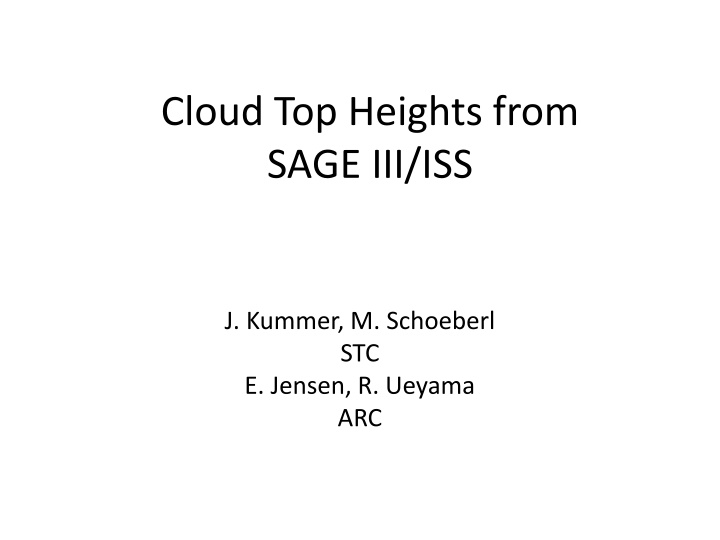
Cloud Identification Algorithms Using SAGE III Data
This content discusses cloud identification algorithms utilizing SAGE III data. It delves into different algorithms, such as those by Thomason and Vernier (2013) and Kent et al. (2007), highlighting their methodologies, comparisons, and applications. The article presents examples, techniques, and a final cloud algorithm that aims to improve accuracy and agreement between different approaches.
Download Presentation

Please find below an Image/Link to download the presentation.
The content on the website is provided AS IS for your information and personal use only. It may not be sold, licensed, or shared on other websites without obtaining consent from the author. If you encounter any issues during the download, it is possible that the publisher has removed the file from their server.
You are allowed to download the files provided on this website for personal or commercial use, subject to the condition that they are used lawfully. All files are the property of their respective owners.
The content on the website is provided AS IS for your information and personal use only. It may not be sold, licensed, or shared on other websites without obtaining consent from the author.
E N D
Presentation Transcript
Cloud Top Heights from SAGE III/ISS J. Kummer, M. Schoeberl STC E. Jensen, R. Ueyama ARC
Outline Review of our SAGE III cloud algorithm Comparison to other observations Future work
How do we identify clouds within the SAGE III profiles? 2 algorithm, Thomason and Vernier (2013) Uses extinction ratio and extinction magnitude Can also be used with SAGE II 3 algorithm, Kent et al. (2007) Uses two extinction ratios Cannot be used with SAGE II
Example of the 2 Algorithm z [km] All TWP Points (2- ) Cloud < 2 > -3.7 x(z)=log10( (z)1020) y(z)= 520 / 1020 x=log10(b1020nm) 9/16/2017 Lat/Lon: -21.45, 30.01
Same case for the 3 algorithm All TWP Points (3- ) Example of x~1 y~1 observation z [km] x(z) y(z) Cloud x =b1020nm b1550nm Extinction Ratio [unitless] 9/16/2017 Lat/Lon: -21.45, 30.01
Case with an Aerosol Layer Profiles of two color ratios All TWP Points (3- ) z [km] x(z) y(z) Aerosols Stratospheric Aerosols Cloud x =b1020nm b1550nm Extinction Ratio [unitless] Lat/Lon: 2.0, 150.55 4/24/2018
Case with an Aerosol Layer All TWP Points (2- ) Profiles of extinction and color ratio z [km] Aerosols Extinction increases while color ratio approaches 1 Cloud x(z)=log10( (z)1020) y(z)= 520 / 1020 x=log10(b1020nm) Lat/Lon: 2.0, 150.55 4/24/2018
Summary of the Two Techniques (June 2017 March 2018 data) 3- (Kent) 2- (Thomason) Ratio 520/1020 threshold = 2 Aerosols Clouds Log(1020 extinction) = -3.7 Clouds
Final Cloud Algorithm The two algorithms disagree where extinctions at 1020 and 1550 are small (basically dividing by a small number). To correct this we modify the Kent algorithm to include the Thomason extinction cutoff. New Kent algorithm: A Cloud is detected if 3- (Color Ratio (520/1020 and 1020/1550 ext.) is 0.75< CR < 2.0 for both ratios And Log10(1020 ext.) > -3.7 constraint from the 2- method. The two algorithms now agree for 93% of the observations.
Validating the SAGE III cloud algorithm with OMPS and CALIOP observations Using all of the SAGE III, OMPS-LP, and CALIOP data available we compare Zonal mean Cloud Top Heights (CTH) Zonal Mean Difference of Cloud Top Heights Relative to OMPS-LP Cloud Top Height Maps
OMPS, SAGE and CALIOP Cloud Detection Extinction Back scattering CALIOP SAGE III Limb Scattering OMPS LP Each system uses a different technique to identify cloud height.
Zonal Mean CTH from SAGE III, OMPS-LP, CALIOP km km CALIOP OMPS SAGE OMPS Latitude
SAGE III Cloud Top Height (annual average) TEP Clouds are more consistent with OMPS TWP Clouds are higher than OMPS. km
Comparison to CALIOP and OMPS SAGE III (1 year of data) Overall, the three data sets are consistent OMPS is ~1 km higher than CALIOP in TWP SAGE III is slightly higher than OMPS in TWP (5 years of data) (7 years of data) OMPS CALIOP
JJA 2017/18 Zonal Mean CTH from SAGE III, OMPS, CALIOP km OMPS and SAGE III are very similar in the tropics Differences km Latitude
SAGE III CTH JJA SAGE III (2017/18) Overall, the three data sets are consistent SAGE III and OMPS are closer Some interesting differences OMPS (2017/18) CALIOP (2017/18)
DJF 2017 Zonal Mean CTH from SAGE III, OMPS, CALIOP km SAGE III is highest Latitude
SAGE III CTH DJF SAGE III (2017) Overall, three data sets are consistent SAGE III is highest Some interesting differences but more data is required (white means no data) OMPS (2017) CALIOP (2017)
Conclusions Both algorithms 2 and 3 produce reasonable SAGE III Cloud Top Height. We use a modified 3 algorithm here (3 m). Comparison with CALIOP and OMPS shows overall good agreement. More SAGE data is required to solidify the comparisons and explore some of the differences.
Future Work Implement a cloud top height detection algorithm operationally. The OMPS radiance gradient cloud identification scheme could also be used with in SAGE III data especially for SAGE III in limb scatter mode. Computation of cloud fraction is an ongoing project Estimating cloud fraction is important for climate studies Converting the CALIOP viewing geometry to SAGE III/OMPS viewing geometry is a challenge since it re horizontal extent of clouds (e.g. Liao et al. 1995) quires an assumption about the
